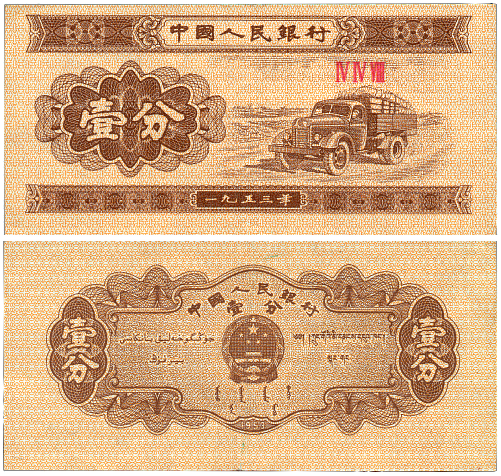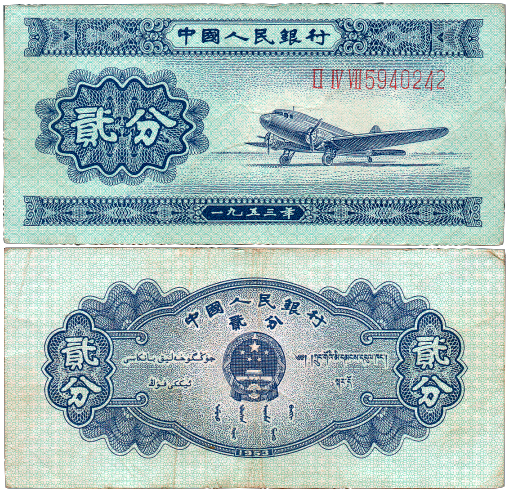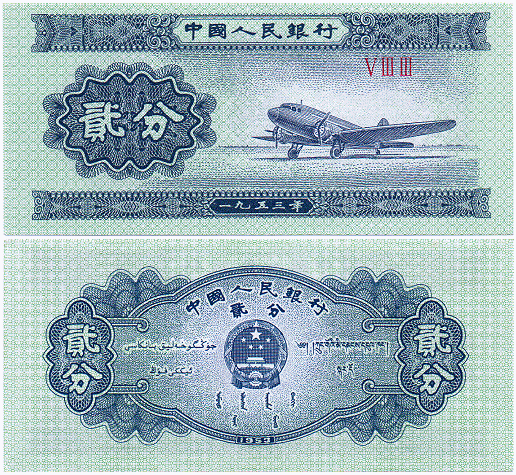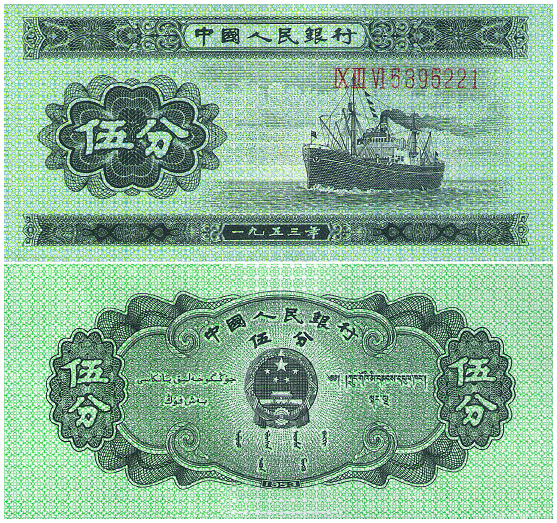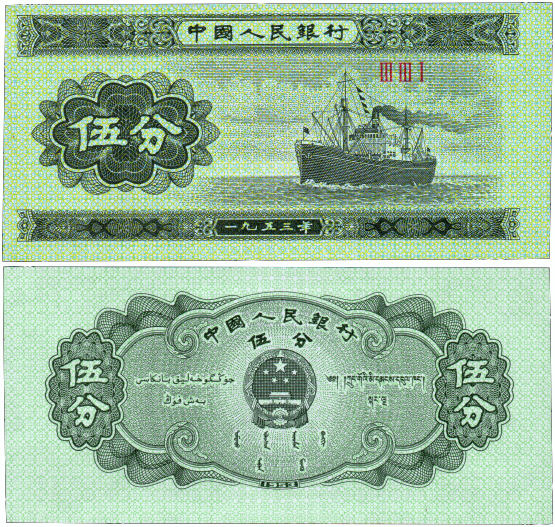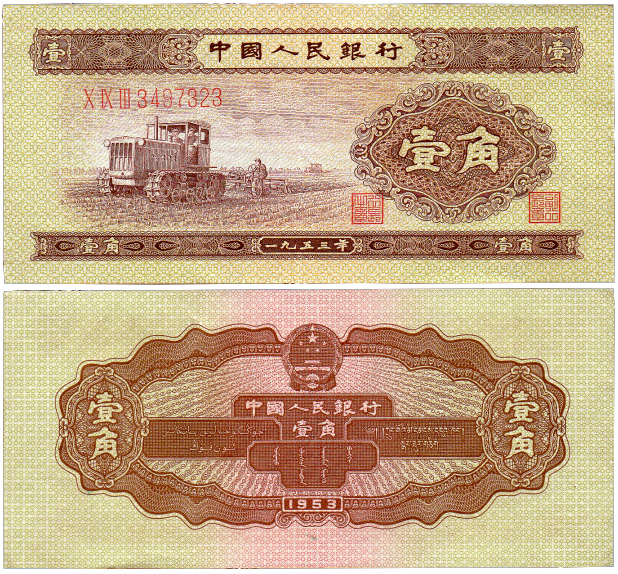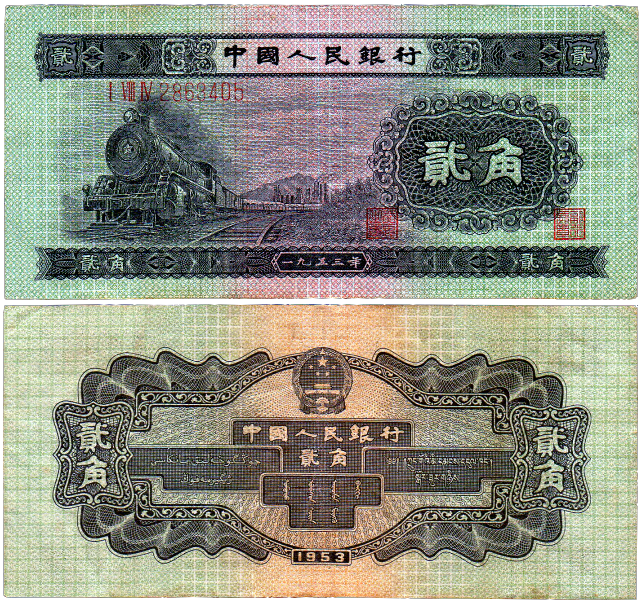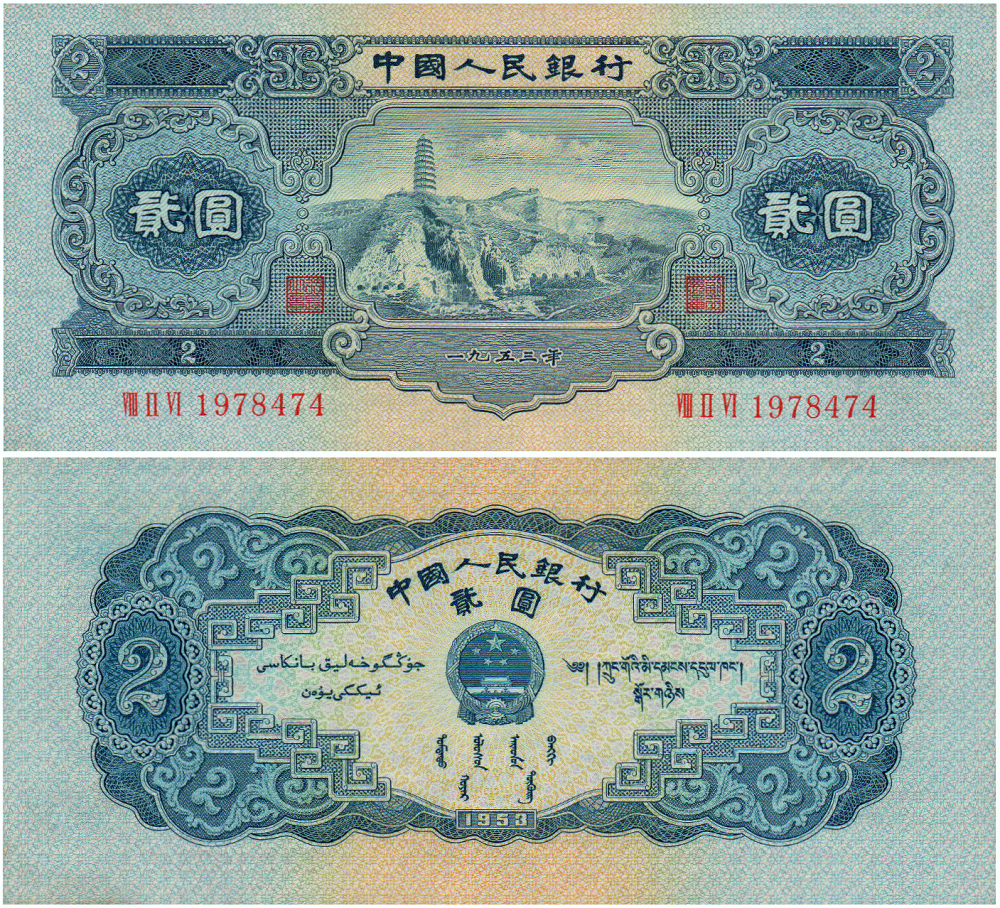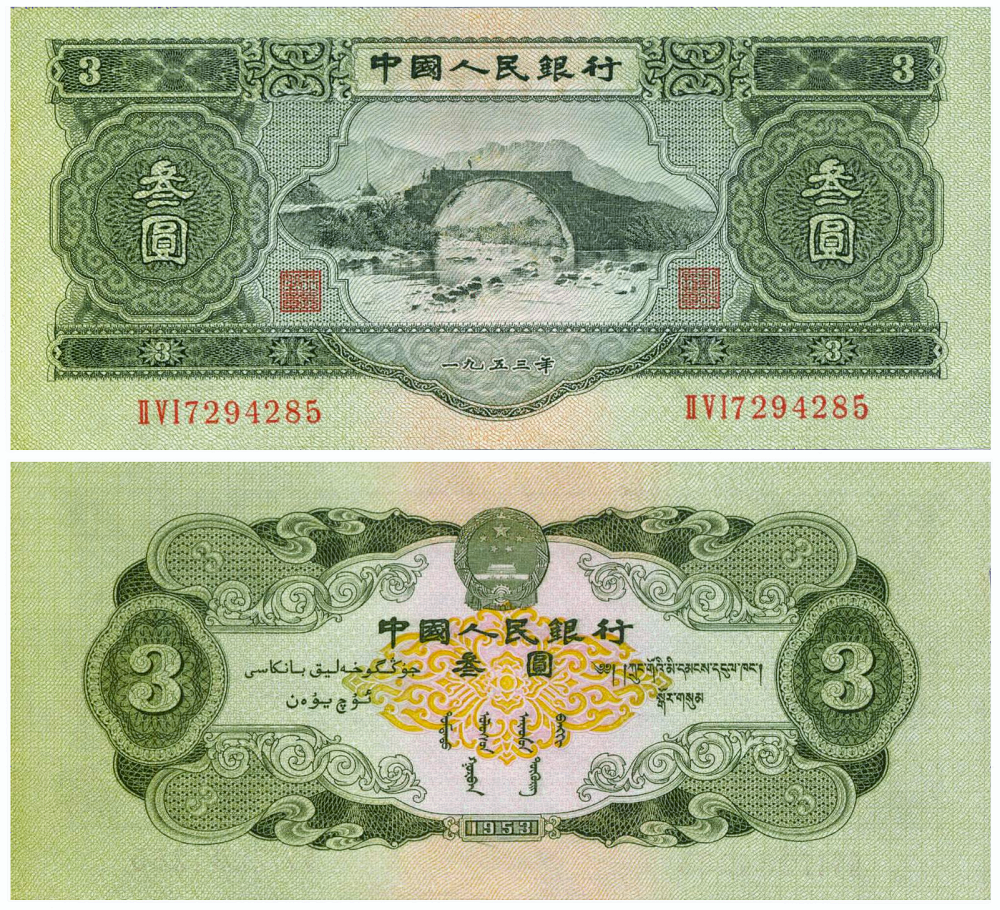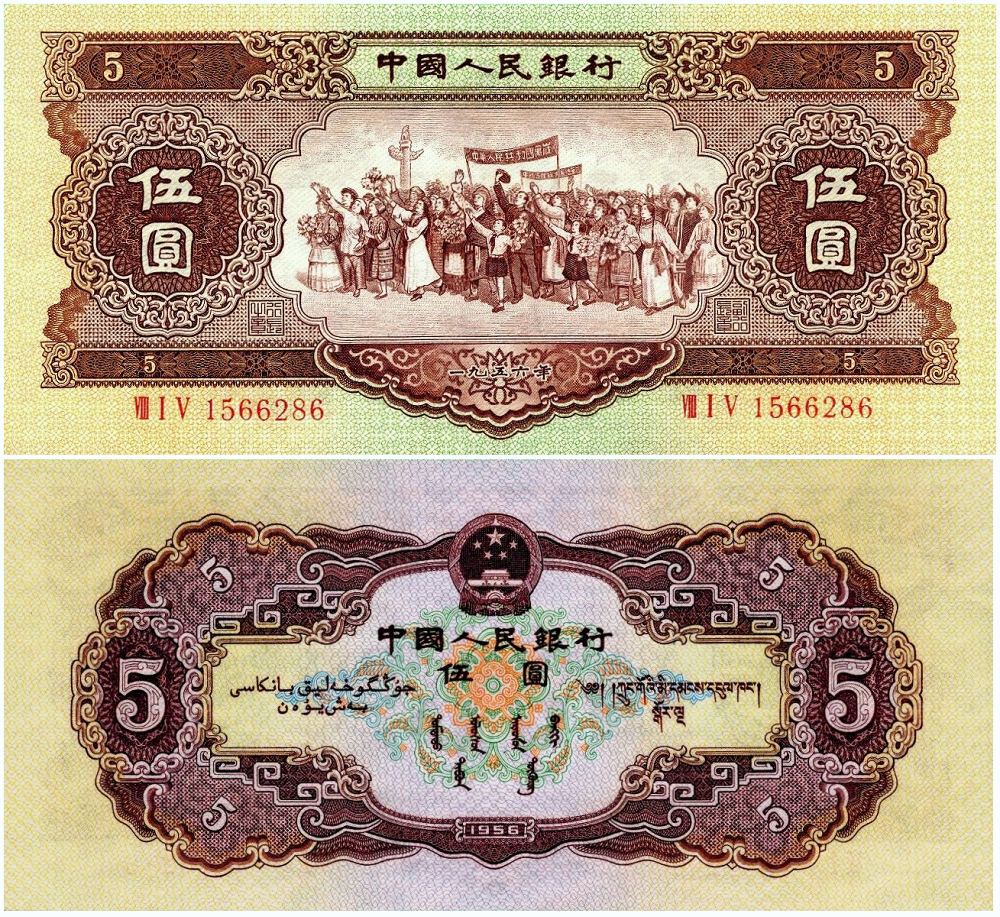November 20 2017 (Updated July 15 2021)
Peoples Bank of China 中國人民銀行: issued and proposed currency issues of 1953-1975
Section One
The yuan or renminbi yuan was introduced in 1948 (Series 1) by the Peoples Bank of China, to supplant the Nationalist yuan. This was revalued in 1955 at the closing stage of the Chinese governments successful campaign to tackle the hyper-inflation which had continued to plague China since the closing years of Nationalist rule. The revaluation was at a rate of 10,000 of the old yuan to 1 new yuan.
The coins and banknotes of the new currency was planned from 1950 and produced from 1953 but not introduced into circulation until March 1st 1955.
For reasons which will be explored below, issues of the '1953' series are conversely among the most common, and the rarest of Peoples Bank issues.
The coins and banknotes of the new currency was planned from 1950 and produced from 1953 but not introduced into circulation until March 1st 1955.
For reasons which will be explored below, issues of the '1953' series are conversely among the most common, and the rarest of Peoples Bank issues.
1953 Second Series Issue (1955)
Preliminary work for the Series 2 '1953' began in 1950, with designs supplied by Luo Gongliu, Zhou Lingzhao and Hou Yimin. The calligraphy for the bank’s name was by Ma Wenwei, a researcher at the Bank’s Head Office, Beijing. The theme of the designs was unity, celebrating the founding of the New China by the people. Some of the higher denominations were criticised however for depicting such as US weaponry and machinery, which the forces and people of China had been given during and after the war, and some of which the Communist Government had 'inherited' from the ousted Nationalists.
|
1 Fen of 1953 (1955)
Issued March 1st 1955. Withdrawn July 1st 2003. Printed by the China Banknote Printing and Minting Corporation.
Brown. (front) a lorry loaded with produce. (back) national coat of arms at centre, texts in Chinese, Uyghur, Tibetan and Mongolian. Type 1 (Krause SCWPM P 860a): full red serial number with roman numeral prefix. Shown right. |
|
2 Fen of 1953 (1955)
Issued March 1st 1955. Withdrawn July 1st 2003. Printed by the China Banknote Printing and Minting Corporation.
Blue. (front) Soviet built Lisunov Li-2 airplane. (back) national coat of arms at centre, texts in Chinese, Uyghur, Tibetan and Mongolian. Type 1 (Krause SCWPM P 861a): full red serial number with roman numeral prefix. Shown right. |
|
5 Fen of 1953 (1955)
Issued March 1st 1955. Withdrawn July 1st 2003. Printed by the China Banknote Printing and Minting Corporation.
Green. (front) ship at sea. (back) national coat of arms at centre, texts in Chinese, Uyghur, Tibetan and Mongolian. Type 1 (Krause SCWPM P 862a): full red serial number with roman numeral prefix. Shown right. |
|
1 Jiao of 1953 (1955)
Issued March 1st 1955. Withdrawn December 15th 1967. Printed by the China Banknote Printing and Minting Corporation.
Brown-violet. (front) tractor. (back) national coat of arms at centre, texts in Chinese, Uyghur, Tibetan and Mongolian. Type 1 (Krause SCWPM P 863): full red serial number with roman numeral prefix. Shown right. |
|
2 Jiao of 1953 (1955)
Issued March 1st 1955. Withdrawn November 15, 1971. Printed by the China Banknote Printing and Minting Corporation.
Black-green. (front) train. (back) national coat of arms at centre, texts in Chinese, Uyghur, Tibetan and Mongolian. Type 1 (Krause SCWPM P 864): full red serial number with roman numeral prefix. Shown right. |
|
5 Jiao of 1953 (1955)
Issued March 1st 1955. Withdrawal date unknown but probably later than that of the 1 and 2 jiao. It may have been withdrawn following the catastrophic failure of a similar hydropower dam in 1975.
Printed by the China Banknote Printing and Minting Corporation. Black-green. (front) hydropower station (dam). (back) national coat of arms at centre, texts in Chinese, Uyghur, Tibetan and Mongolian. Watermark: stars. Type 1 (Krause SCWPM P 865): full red serial number with roman numeral prefix. Shown right. |
|
1 Yuan of 1953 (1955)
Issued March 1st 1955. Withdrawn October 20, 1969. Printed by the China Banknote Printing and Minting Corporation.
Red-orange/pink. (front) Tiananmen Gate. (back) national coat of arms at centre, texts in Chinese, Uyghur, Tibetan and Mongolian. Watermark. Located to the north of the Tiananmen Square, the Tiananmen Gate is a spectacular vermilion building with yellow glazed tiles. The Gate was first constructed in the 15th year of Emperor Yongle's Reign in the Ming Dynasty (1417 AD), and was the site on October 1st 1949, of Chairman Mao's proclamation of the founding of the Peoples Republic to the world. Type 1 (Krause SCWPM P 866): full red serial number with roman numeral prefix. Shown upper right. Right: period counterfeits of the 1953 1 Yuan.
|
|
2 Yuan of 1953 (1955)
Issued March 1st 1955. Withdrawn December 1976. Printed by the China Banknote Printing and Minting Corporation.
Blue-orange. (front) a Song dynasty pagoda on a clifftop: Mount Baota/Jialing. (back) national coat of arms at centre, texts in Chinese, Uyghur, Tibetan and Mongolian. Watermark. Mount Baota (Treasure Pagoda), or Mount Jialing, is located southeast of Yanan, in Shaanxi province. The Pagoda was built in the Song Dynasty (618 ~ 907 AD). An iron bell next to the pagoda was built during the Ming Dynasty (1368-1644 AD). When the communist party was in Yanan, the bell was used to tell the time and as an alarm. In 1927, after the first failure of communist revolution, Mao Tse-Tung and Zhu De led their followers to establish a base in Mount Jinggang, Jiangxi. Under the Nationalist's pressure, the Red Army was forced to leave Jinggang, which was later called "the long march", during 1934-1935, and ended at Mount Baota, Shaanxi. Hence these two mountains have a special meaning in the history of the communist revolution. Type 1 (Krause SCWPM P 867): full red serial number with roman numeral prefix. Shown upper right. |
|
3 Yuan of 1953 (1955)
Issued March 1st 1955. Withdrawn April 15, 1964. Printed within the Soviet Union. The Sino-Soviet split led to the early withdrawal of this note and the abolition of this 'Russian' denomination alltogether.
Green. (front) a stone bridge with the Jinggang Mountains beyond (back) national coat of arms at centre, texts in Chinese, Uyghur, Tibetan and Mongolian. Watermark. In 1927, after the first failure of communist revolution, Mao Tse-Tung and Zhu De led their followers to establish a base in Mount Jinggang, Jiangxi. Under the Nationalist's pressure, the Red Army was forced to leave Jinggang, which was later called "the long march", during 1934-1935, and ended at Mount Baota, Shaanxi. Hence these two mountains have a special meaning in the history of the communist revolution. The mountains boast 100 plus peaks in a variety of unusual forms, and, are home to a considerable diversity of plants and animals. Type 1 (Krause SCWPM P 868): full red serial number with roman numeral prefix. Shown right. |
|
5 Yuan of 1953 (1955)
Issued March 1st 1955. Withdrawn April 15 1964. Printed within the Soviet Union. The Sino-Soviet split led to the early withdrawal of this note, and it's replacement with the similar 1956 issue (see below).
Red-brown-lilac. (front) jubilant crowd with banners - national unity. (back) national coat of arms at centre, texts in Chinese, Uyghur, Tibetan and Mongolian. Watermark. The vignette is intended to show the unity of the numerous ethnic groups within China of which there are (officially) 55, plus the dominant Han Chinese. Type 1 (Krause SCWPM P 869): full red serial number with roman numeral prefix. Shown right. Similar to 1956 issue. |
|
10 Yuan of 1953 (1957)
Issued December 1st 1957. Withdrawn April 15, 1964. Printed within the Soviet Union. The Sino-Soviet split led to the early withdrawal of this note.
Black-grey. (front) Couple at centre; labourer pointing at left, farmer holding wheat sheaf at right. (back) national coat of arms at centre, texts in Chinese, Uyghur, Tibetan and Mongolian. Watermark. Type 1 (Krause SCWPM P 870): full red serial number with roman numeral prefix. Shown right. |
1956
|
1 Yuan of 1956 (1961)
Issued March 25th 1961. Withdrawn August 15th 1973. Banknote Printing and Minting Corporation.
Black-grey/orange-pink. (front) Tiananmen Gate. (back) national coat of arms at centre, texts in Chinese, Uyghur, Tibetan and Mongolian. Watermark. Located to the north of the Tiananmen Square, the Tiananmen Gate is a spectacular vermilion building with yellow glazed tiles. The Gate was first constructed in the 15th year of Emperor Yongle's Reign in the Ming Dynasty (1417 AD), and was the site on October 1st 1949, of Chairman Mao's proclamation of the founding of the Peoples Republic to the world. Type 1 (Krause SCWPM P 871): full red serial number with roman numeral prefix. Shown right. |
|
5 Yuan of 1956 (1962)
Issued April 20th 1962. Withdrawn December 1st 1983. Printed by the China Banknote Printing and Minting Corporation.
Brown-multicolour. (front) jubilant crowd with banners - national unity. (back) national coat of arms at centre, texts in Chinese, Uyghur, Tibetan and Mongolian. Watermark. The vignette is intended to show the unity of the numerous ethnic groups within China of which there are (officially) 55, plus the dominant Han Chinese. Type 1 (Krause SCWPM P 872): full red serial number with roman numeral prefix. Shown right. Similar to '1955' issue. |

